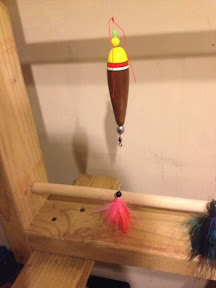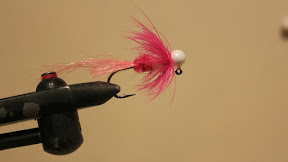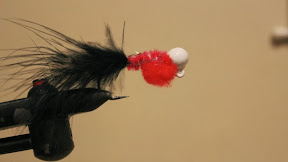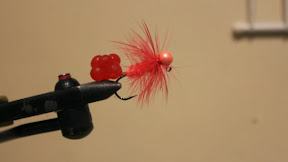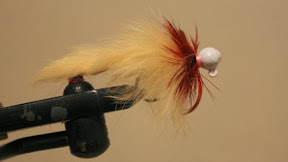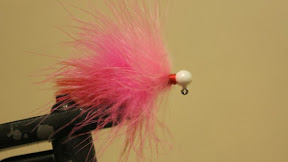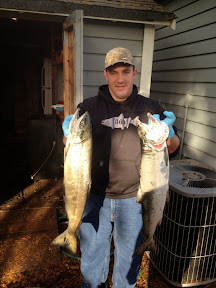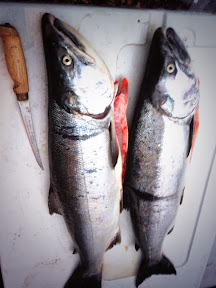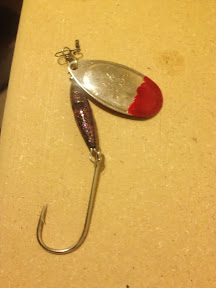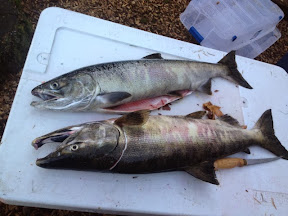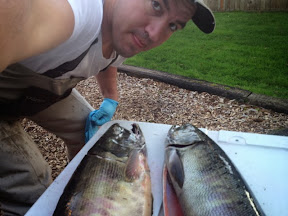
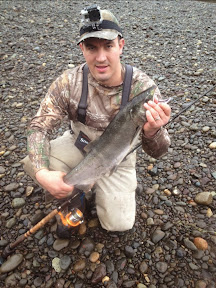
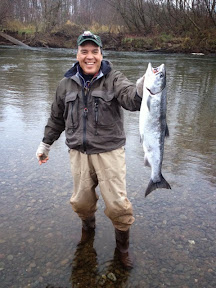

To order this coho killer go to www.fishtaletackle.com

"Where to Twitch"
Areas where the current is mild, such as deep pools, back eddies, and areas around submerged wood tend to be prime jigging zones. Coho Salmon love holding in areas where there is cover, so any area where the current is moving slowly and has some depth too it can be prime.
Coho Salmon Holding Water…
- Slow current
- Deep water
- Submerged logs & woody debris
So if you stumble upon an area that has all three, you’ve got perfect Coho holding water, thus a perfect place to twitch jigs.
"Color and Size"
Once you’ve pinpointed an area where Coho are holding, the main two things that need to be considered are jig choice and jigging method. Consider your fishing situation. Are the Coho super aggressive? Are the Coho lockjawed? Is the water clear? How close to tidewater? Have the fish been in the river a while? How deep is the water? These are just a few of the questions that run through my mind while I’m considering jig choice. I might fish a large bright pink jig near tidewater if I think there are aggressive Coho nearby, but if I am upriver and Coho have been in the river a while, then I might downsize to a smaller profile jig that is a dark blue or purple.Typically salmon jigs that are ¼ oz, 3/8 oz or ½ oz are preferred. Salmon jigs can be tied with marabou feathers, rabbit fur, or just be a jighead pushed into the head of a plastic squid. Color patterns vary from river to river so experimentation is sometimes needed when you trying to get fish you know are there to bight.
"Twitching or Jigging"
Jigging is a very universal term in the fishing realm, lifting the rod tip to lift the jig, and then dropping the rod tip to allow the jig to fall. To trigger a strike from Coho, it is all about the lift & fall. The rising and falling motion of the jig creates a reactionary instinct that is triggered. Depending on the demeanor or the fish in the river at that time, they might want an aggressive retrieve or a more mild retrieve. I’ve seen quite a few methods for twitching jigs. Some anglers prefer a short-quick lift and fall method, while other anglers prefer a big-quick lift with a slow fall. Experiment untill you find the preferred method. Recognize that Coho will hold near the river bottom, or suspend near submerged wood. If there is wood in the river, then an accurate cast near the structure is very important. Coho will often hold so tight to the wood that drifting anything could mean an instant snag up. But pitching a jig and letting it fall can often lure Coho out of those tight spots.
Rod: Look for a rod that is 8’6" to 9’ in (you don’t want a flimsy rod that bends when you’re trying to lift the jig).
Line: 20#-30# braided lines offer strength paired with thin diameter. They also offer zero stretch, which is beneficial when jigging. The control over the jig is much greater with braid plus if a jig is snagged, there is a better chance that you can get it back.
When fishing near wood, lures often get snagged up. If a jig is retrieved but the hook is bent straight, only bend it back into fishable shape once or twice. Be aware, every time that a hook is bent, it loses its strength a little more each time and is more likely to bend out when a fish is actually hooked. I would reshape a jig no more than two times.
Focus on areas where there is ample depth, slow current, and woody structure.
Experiment with jigging speed. Coho will sometimes best respond to an erratic speedy retrieve, and other times a slow lift/fall tactic is most productive.
Jig color is a key factor and the preferred color can change from day to day. Generally speaking, Pinks, Red, Blacks, Purples and Blues are the best colors.
Choose braided lines over monofilament. The control over the jig is much greater with braid plus if a jig is snagged, there is a better chance that you can get it back.
Loser Takes All!

